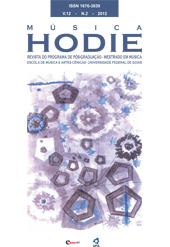Notational Practice of Complex Music
DOI:
https://doi.org/10.5216/mh.v12i2.23529Abstract
This paper suggests that rhythmic notational practice seen in complex music adhere to the principle that the number of beams/flags of any note is dependent upon the number of iterations per temporal unit. In the first instance this may seem obvious, since this principle forms the basis of rational rhythmic notation in music. However, with music featuring nested tuplets of two levels or more, an interesting phenomena begins to occur in which the divisions of a unit become decoupled from the expectations of rhythmic ratios, such as three in the space of the last note of a triplet. Therefore, the intent of this paper is to provide a series of proofs to show that the number of iterations per (divisions of) unit take precedence over the expectations of ratios when such mismatches occur. Keywords: Complexity in rhythm, Notation in contemporary music, Nested tuplets, Rhythmic notational practice.Downloads
Download data is not yet available.
Published
2013-04-05
How to Cite
EDWARD EDGERTON, Michael. Notational Practice of Complex Music. MÚSICA HODIE, Goiânia, v. 12, n. 2, 2013. DOI: 10.5216/mh.v12i2.23529. Disponível em: https://revistas.ufg.br/musica/article/view/23529. Acesso em: 25 dec. 2025.
Issue
Section
Outras Palavras















